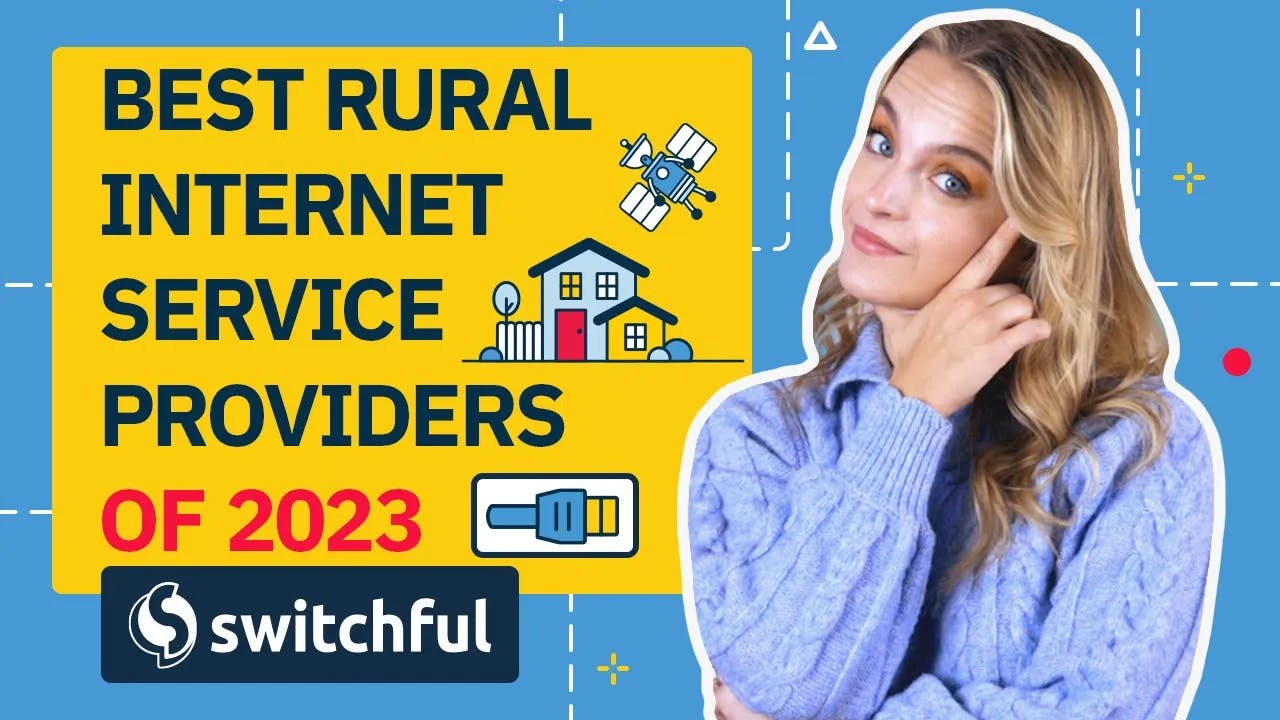Best internet providers for rural areas in 2024

We’ve picked CenturyLink as the best rural internet provider. CenturyLink is widely available and offers great DSL availability in remote areas. You can get a reliable, wired internet connection even where cable and fiber don’t reach. CenturyLink offers low prices, no contracts, 24/7 customer support, and unlimited data. All of this makes CenturyLink an attractive internet option for many households.

Best internet providers for rural areas
- Plans starting at $30.00 - $110.00
- Download speeds up to 940Mb
- Upload speeds up to 940Mb
Disclaimer: Availability and pricing are subject to location. Conditions apply. For offer details, view disclaimers
- Plans starting at $25.00 - $100.00
- Download speeds up to 1000 Mbps
- Upload speeds up to n/a
Disclaimer: Availability and pricing are subject to location. Conditions apply. For offer details, view disclaimers
- Plans starting at $30.00 - $349.99
- Download speeds up to 100 Mbps
- Upload speeds up to 3 Mbps
Disclaimer: Availability and pricing are subject to location. Conditions apply.
- Plans starting at $49.99 - $174.99
- Download speeds up to 25 Mbps
- Upload speeds up to 3 Mbps
The HughesNet Gen5 service plans are designed to deliver download speeds of 25 Mbps and upload speeds of 3 Mbps, but individual customers may experience different speeds at different times of the day. Speeds and uninterrupted use are not guaranteed and may vary based on a variety of factors including: the configuration of your computer, the number of concurrent users, network or Internet congestion, the capabilities and content of the websites you are accessing, network management practices as deemed necessary, and other factors. When you connect to the HughesNet service using Wi-Fi, your experience will vary based on your proximity to the Wi-Fi source and the strength of the signal.
Methodology for evaluating rural internet providers
If you live in a remote area, your choices for home internet service will be limited. After all, only around a quarter of all rural households have access to internet speeds of 25 Mbps or more. (1) Far fewer rural areas can get the fastest types of internet. Fiber and cable internet providers have the best value and performance, but if they don’t offer service at your address, you’ll need to consider alternatives.
We’ve selected providers that offer DSL, fixed wireless, and satellite internet because of their availability in rural areas. To determine our rankings, we looked at performance and value. For more information on how we chose the best rural internet providers, see our full methodology.


#1: CenturyLink internet

- Unlimited data across all plans
- Fast fiber connections in select markets
- No contracts
- Limited fiber availability
- Much slower DSL internet speeds
- Below-average customer service
Disclaimer: Availability and pricing are subject to location. Conditions apply. For offer details, view disclaimers
CenturyLink offers great DSL internet in most areas
CenturyLink offers many type of internet connection options. It earns #1 pick on this list thanks to its exceptionally good DSL availability in rural and remote areas. CenturyLink offers service in 16 states and has low prices starting at $50 per month. Its DSL speeds are typical, ranging from below broadband up to 100 Mbps. Speeds will depend on your location, and we recommend getting at least 25 Mbps download speed if you can.
CenturyLink has average customer service and reliability, unlimited data, and no contracts are required. If CenturyLink isn’t available for your home, it’s worth checking out comparable providers that offer DSL to many rural areas like Kinetic by Windstream or Frontier.
#2: Rise Broadband internet

- Strong rural availability
- More data than satellite
- Low latency
- Limited speeds
- weather can impact service
Disclaimer: Availability and pricing are subject to location. Conditions apply. For offer details, view disclaimers
Rise Broadband's fixed wireless internet beats the alternative
Rise Broadband provides fixed wireless internet service. It was named CNET's best overall rural internet provider in 2021. Since Rise Broadband is wireless internet, you don’t need to have cable or phone lines at your address.
Rise Broadband is available in rural and suburban areas in 16 states across the country, from the Midwest to the Southwest. Speeds in most locations range from 25 Mbps to 50 Mbps, which can beat some DSL offerings. In some locations, you can get speeds up to 250 Mbps. Rise Broadband's internet performance is generally reliable, but severe weather can occasionally cause disruptions.
Prices start as low as $45 per month with free installation (a $150 value). No contracts are required, and there’s even a 30-day satisfaction guarantee. Unlimited data plans are sometimes available.
Fixed wireless internet generally offers much better performance and value than satellite internet, so Rise Broadband comes in ahead of competitors like Viasat and HughesNet in our list of rankings. If you can’t get Rise Broadband, AT&T Fixed Wireless also provides service to select rural areas.
#3: Viasat internet

- Fast speeds for satellite
- Variety of plans
- Wide availability
- High prices
- Caps on high-speed data
Disclaimer: Availability and pricing are subject to location. Conditions apply.
Viasat offers reliable satellite internet with no contract
Satellite internet has the best availability of any internet connection type and may be your only choice in some remote locations. Viasat is available to 99% of the US population. All you need is to be able to place a satellite in view of the southern sky to capture the signal.
Viasat offers high download speeds. You can get internet speeds up to 150 Mbps, and the most generous high-speed data limit (usually up to 150 GB, but 300 GB is sometimes available). Data is technically unlimited, so you won’t have to fear unplanned overage charges. But the high-speed data caps are on the low side, and your speed will be limited to a crawl after reaching your limit.
Viasat offers equipment leasing and fairly comparable pricing to other rural providers. Plus, you can get a month-to-month contract with no long-term commitment. For installation, professional technicians will come to your home to get your internet up and running.
#4: HughesNet internet

- Affordable satellite internet
- Wide availability
- Unlimited data available
- Price may increase
- Two-year contract
The HughesNet Gen5 service plans are designed to deliver download speeds of 25 Mbps and upload speeds of 3 Mbps, but individual customers may experience different speeds at different times of the day. Speeds and uninterrupted use are not guaranteed and may vary based on a variety of factors including: the configuration of your computer, the number of concurrent users, network or Internet congestion, the capabilities and content of the websites you are accessing, network management practices as deemed necessary, and other factors. When you connect to the HughesNet service using Wi-Fi, your experience will vary based on your proximity to the Wi-Fi source and the strength of the signal.
HughestNet offers fast, affordable satellite internet
HughesNet offers broadband satellite internet service with internet speeds up to 100 Mbps. Plan costs vary based on how much high-speed data you choose, and there is no hard data limit. You can get speeds up to 50 Mbps for about $49.99 a month for 12 months and speeds up to 100 Mbps for $94.99 a month for 12 months.
HughesNet has more affordable plans for its speed than Viasat, and you can get higher speeds. HughesNet's relatively new Fusion plan means you get satellite internet at fast speeds for the whole household. You tend to get less lag and latency, and you can have multiple household members online at the same time.
HughesNet is best for those who want whole home Wi-Fi and fast internet speeds with their satellite internet service.
What to consider when choosing rural internet providers:
If you live far from a city and can’t get fiber or cable internet, your best options for availability are DSL, fixed wireless, or satellite internet. Performance and value depend heavily on which connection type you choose.

Availability
Satellite internet has the best availability of any internet connection type, and it covers almost any rural area. DSL also has very wide availability because it uses phone lines to deliver internet service. Fixed wireless is harder to find since it’s a newer technology, but you can sometimes get it in rural areas without wired connection options.
See our full list of internet providers if you want to compare options in your aread.
Performance
DSL has maximum download speeds of about 100 Mbps, and though that’s much slower than cable, it’s still a good way to get a reliable, wired internet connection. Fixed wireless usually has speed options that can match or exceed DSL and has better performance than satellite internet. Satellite internet performance isn’t great. It has low data caps, low upload speeds, major lag, and reliability issues, which makes it a poor choice for those who work from home, stream a lot of videos, or make video calls.
Find out how much internet speed your household needs.
Value
You’re likely to find the best value with either DSL or fixed wireless, depending on what speeds are available in your area. DSL is relatively cheap, and fixed wireless providers often have similar speeds and pricing (or better). Satellite internet tends to be expensive, especially considering its lackluster performance and low data caps.
Brittany is a Contributing Writer for Switchful with over five years of experience writing about technology in the US and Europe. Her primary focus is on mobile and internet topics. She is passionate about helping people choose the right tech for their needs at the right price.
Bri Field has a background in academia, research writing, and brand marketing. She has edited scientific publications, conference papers, digital content, and technical communications. As Assigning Editor, she enjoys ensuring all content is accurate, clear, and helpful. In her free time, you can find her in the kitchen trying a new recipe, out on a hike, or working through her massive TBR list.
Endnotes and sources
1. 2020 Broadband Deployment Report, FCC. Accessed 1/16 2023
